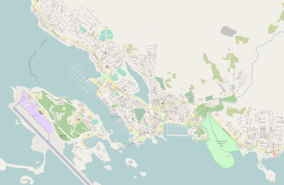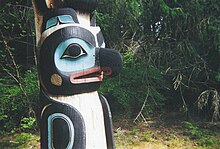
Totem poles are monumental carvings found in western Canada and the northwestern United States. They are a type of Northwest Coast art, consisting of poles, posts or pillars, carved with symbols or figures. They are usually made from large trees, mostly western red cedar, by First Nations and Indigenous peoples of the Pacific Northwest Coast including northern Northwest Coast Haida, Tlingit, and Tsimshian communities in Southeast Alaska and British Columbia, Kwakwaka'wakw and Nuu-chah-nulth communities in southern British Columbia, and the Coast Salish communities in Washington and British Columbia.

Sitka is a unified city-borough in the southeast portion of the U.S. state of Alaska. It was under Russian rule from 1799 to 1867. The city is situated on the west side of Baranof Island and the south half of Chichagof Island in the Alexander Archipelago of the Pacific Ocean. As of the 2020 census, Sitka had a population of 8,458, the fifth-most populated city in the state.

Ketchikan is a city in and the borough seat of the Ketchikan Gateway Borough of Alaska. It is the state's southeasternmost major settlement. Downtown Ketchikan is a National Historic District.

Kasaan is a city in the Prince of Wales-Hyder Census Area in the U.S. state of Alaska. The population was 49 at the 2010 census, up from 39 in 2000. The name "Kasaan" comes from Tlingit Kasa'aan, meaning "pretty town".

The City and Borough of Wrangell is a borough in Alaska, United States. As of the 2020 census the population was 2,127, down from 2,369 in 2010.

The Battle of Sitka was the last major armed conflict between Russians and Alaska Natives, and was initiated in response to the destruction of a Russian trading post two years before. The primary combatant groups were the Kiks.ádi Clan of Sheetʼká Xʼáatʼi of the Tlingit nation and agents of the Russian-American Company assisted by the Imperial Russian Navy.

The Alaska Governor's Mansion, located at 716 Calhoun Avenue in Juneau, Alaska, is the official residence of the governor of Alaska, the first spouse of Alaska, and their families. It was designed by James Knox Taylor. The Governor's Mansion was first occupied in 1912 by Territorial Governor Walter Eli Clark.
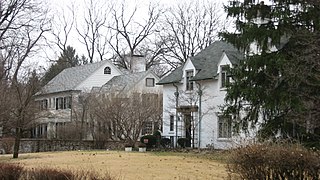
Golden Hill is an affluent and historic neighborhood overlooking the White River on the west side of Indianapolis's Center Township, in Marion County, Indiana. The district is bounded on the east by Clifton Street, which is west of Martin Luther King Jr. Boulevard ; on the west by the White River and the Central Canal; on the south by Thirty-sixth Street; and on the north by Woodstock Country Club, immediately south of Thirty-eighth Street. Golden Hill is noted for its collection of homes designed by several of the city's prominent architects. The estate homes reflect several styles of period revival architecture. The district is known as for its community planning and remains an exclusive enclave for the city's prominent families. Golden Hill was added to the National Register of Historic Places in 1991.

Castle Hill also known as the American Flag-Raising Site and now as the Baranof Castle State Historic Site, is a National Historic Landmark and state park in Sitka, Alaska. The hill, providing a commanding view over the city, is the historical site of Tlingit and Russian forts, and the location where Russian Alaska was formally handed over to the United States in 1867. It is also where the 49-star United States flag was first flown after Alaska became a state in 1959.
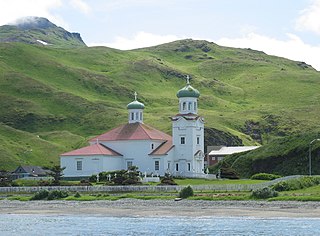
The Church of the Holy Ascension, also known as the Holy Ascension Orthodox Church, is a prominent landmark in Unalaska, the major community of the western Aleutian Islands in southwestern Alaska. The current church was built in 1894, probably on the site of an 1826 church, and likely using timbers and other elements from the older church. It is one of the oldest churches in Alaska, and is significant as the site from which missionaries brought their religion to the local Aleut people. This evangelization effort was so successful that today's Aleut population is still strongly Orthodox. The church was declared a National Historic Landmark for its architecture, and for its role in the history and culture of Alaska. It is the second cathedral church of the Orthodox Church in America Diocese of Alaska, after St. Michael's Cathedral in Sitka.

The Alaska Native Brotherhood (ANB) and its counterpart, the Alaska Native Sisterhood (ANS), are two nonprofit organizations founded to address racism against Alaska Native peoples in Alaska. ANB was formed in 1912 and ANS founded three years later. For the first half of the 20th century, they were the only organizations working for the civil rights of Alaska Natives in the territory and state.

Fort Tongass was a United States Army base on Tongass Island, in the southernmost Alaska Panhandle, located adjacent to the village of the group of Tlingit people on the east side of the island. Fort Tongass was the first US Army base established in Alaska following its purchase from the Russian Empire in 1867 and was garrisoned by the 2nd U.S. Artillery under the command of Captain Charles H. Peirce. Historian Hubert Howe Bancroft notes: "the site was well chosen, containing a plentiful supply of timber and pasture, while fish and game abound in the neighbourhood.

The St. Nicholas Russian Orthodox Church in Juneau, Alaska, United States, was built in 1893 and was listed on the National Register of Historic Places in 1973. Now it is under Diocese of Alaska of the Orthodox Church in America.

Baranof Island is an island in the northern Alexander Archipelago in the Alaska Panhandle, in Alaska. The name "Baranof" was given to the island in 1805 by Imperial Russian Navy captain U. F. Lisianski in honor of Alexander Andreyevich Baranov. It was called Sheet’-ká X'áat'l by the native Tlingit people. It is the smallest of the ABC islands of Alaska. The indigenous group native to the island, the Tlingit, named the island Shee Atika. Baranof island is home to a diverse ecosystem, which made it a prime location for the fur trading company, the Russian American Company. Russian occupation in Baranof Island impacted not only the indigenous population as well as the ecology of the island, but also led to the United States' current ownership over the land.

The Redoubt St. Archangel Michael Site, also known as the Old Sitka Site and now in Old Sitka State Historical Park, is a National Historic Landmark near Sitka, Alaska. Now of archaeological interest, the site, about 7 miles (11 km) north of Sitka at the end of Halibut Point Road, was the site of the early Russian-American Company settlement known as Redoubt St. Archangel Michael. It was the first non-Native settlement on Baranof Island. It was declared a National Historic Landmark in 1962, and was made a state park in 1966.

The Totem Heritage Center is a historical and cultural museum founded in 1976 and located in Ketchikan, Alaska. The center is operated by the city of Ketchikan.

The Chief Kashakes House, also known as the Eagle Tail House and Chief Kah-Shakes House, is a historic Tlingit clan house in Saxman, Alaska. Built in 1895 using balloon framing, the two story wood-frame structure was the first structure built in Saxman, and is the only surviving clan house of its type there. It has a hip roof, and is clad in shiplap siding. The front originally had a porch extending across the full width, but this has been reduced to just the central portion. Three totem poles flank the building, two eagle-topped poles to the right and a beaver pole to the left. An old Russian cannon stands near the house.
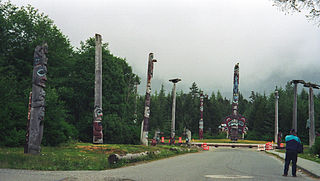
Saxman Totem Park is a public park in the city of Saxman, Alaska, just south of Ketchikan in southeastern Alaska. The park is home to a collection of totem poles, some of which are old poles relocated to this place from unoccupied Tlingit villages in the region, or were reconstructed by skilled Tlingit carvers under the auspices of the Civilian Conservation Corps in the 1930s. The poles originated in the communities of Old Tongass, Cat Island, Village Island, Pennock Island, and Fox Village. One of the carved items recovered from unoccupied villages is a marble statue of a grizzly bear. The park was listed on the National Register of Historic Places in 1979.
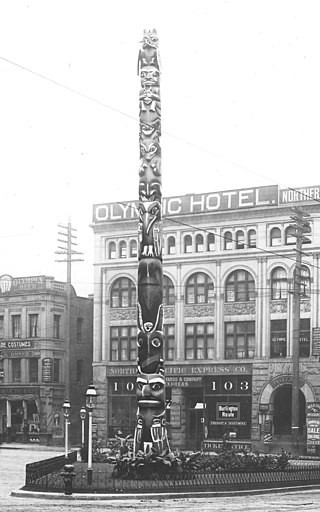
The Pioneer Square totem pole, also referred to as the Seattle totem pole and historically as the Chief-of-All-Women pole, is a Tlingit totem pole located in Pioneer Square in downtown Seattle, Washington.
Ellen Hope Hays was the first Alaska Native woman to be appointed superintendent of a national park. During her 16-year career with the National Park Service, she worked to teach and preserve the culture of Alaska Natives.


